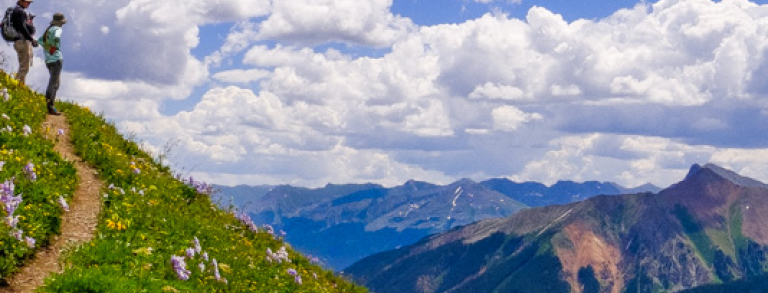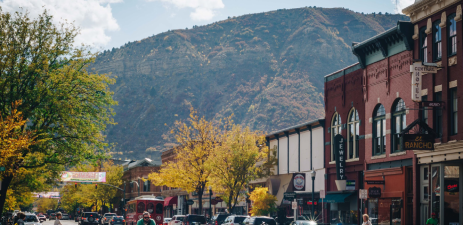YEARS AGO, a bumper sticker appeared: “Durango. Because Every Other Place Just Sucks.” It was undoubtedly the harshest, rudest, and most sanctimonious explanation for one’s choice of hometown.
Let’s just say the local Chamber of Commerce wasn’t amused. Nor was the Durango Area Association of Realtors, though I would guess that its members secretly concurred and were privately thrilled.
I still chuckle every time I recall seeing this snarky declaration. The bumper sticker was endemic to older Subarus and Toyota Forerunners, usually featuring roof racks loaded with mountain bikes, skis, kayaks, and whatnot.
The joke was (and still is) that in Durango, the stuff on top of your car is worth way more than your car. Likewise, a Durangoan’s “best outfit” is the fleece jacket that’s not covered in dog hair. How do you leave Durango with a million dollars? Move here with two million. (Cue the rimshot.)
But seriously, Durango casts a powerful spell. It’s much akin to the opening lines of Pat Conroy’s novel The Prince of Tides: “My wound is geography. It is also my anchorage, my port of call.”
While this novel (one of the best books ever written, in my opinion) is set in the South, those words equally describe the magnetic pull of Durango, a Rocky Mountain boomtown fortuitously sandwiched between mountains and high desert, featuring a vista of stark mesas and a sawtooth panorama of peaks.
This geography should absolutely be your NARGS port of call in 2021.
Within a 50-mile (80 km) radius of Durango, the USDA horticultural zones range from 7a to 3b. Not that zone-denying rock gardeners ever pay much heed to hardiness limitations.
One topographical fact stands out, literally and figuratively. Within that radius, the elevation changes 8,600 vertical feet (2621 m), from the confluence of the San Juan and Animas rivers to the south, thence northward to the summit of Wilson Peak, a fabled “Fourteener.”
People ‘round these parts call 14,000-foot-tall (4267.2 m) peaks “Fourteeners.” (Does that mean enlightened folks using the metric system would refer to these lofty summits colloquially as “Forty-Two Sixty-Seven Point Two-ers?” Um, probably not.)
Even if you have never visited southwest Colorado, you have seen Wilson Peak. It’s the mountain image on cans of Coors Light beer. But that’s beside the point.
I heard the siren song of Durango in 1984. At first, it was a gentle whisper. Fresh out of journalism school and yearning to be independent, I took the first job offered: assistant news editor of the Durango Herald.
I had never heard of Durango, and to be perfectly honest, I wasn’t a fan of small rural towns. In Utah, my erstwhile habitat, small towns are, well, small towns. There’s not much there there. Except for a place called Park City, where a summer internship instilled a fondness for touristy mountain towns and where people would inevitably conclude, “it’s a wonderful place to visit but...”
I didn’t even have a car. But I had my moped. Undaunted, I loaded it into the back of a rented cargo van along with a dozen cardboard boxes containing worldly possessions. In my pocket was a cashier’s check for less than a thousand bucks, my life savings. Mom and my stepdad, proud but holding back tears, dropped me off on the doorstep of the one person I knew in this southwest Colorado town and drove back to Salt Lake City.
Durango sort of reminded me of Park City with its bustling downtown lined with Victorian-era brick buildings, and replete with watering holes, art galleries, shops, restaurants, offices, proprietorships, and mercantile establishments.
This place, however, was distinctly different. It had the feel of an authentic mountain hometown, not just a Western-veneered vacation destination. For example, Durango (back then) had a Woolworth luncheon counter that served a killer grilled cheese sandwich, along with chips and a Coke. There was a hardware store on Main. People on the street said “hi” even if they didn’t know you.
I planned to live here for a season or two, then move on to The Big City. That was 36 years ago. Siren song indeed. More like a vortex. Who could resist?
Imagine yourself in Durango on a mid-June morning. It’s a crisp 50 degrees (10°C) as the sun rises over the Fort Lewis College campus overlooking town. On a bench perched along the plateau’s rim, you enjoy a tall cup of robust coffee and gaze across the verdant small town spread out before you, all bisected by the Animas River, a.k.a. El Río de las Ánimas or “the River of Lost Souls.” Instead of lost, you feel right at home.
The quiet is pierced by a wailing steam whistle announcing the departure of the world-famous Durango and Silverton Narrow Gauge Railroad. Built in 1881, the line was constructed to haul silver and gold ore from the San Juan Mountains. But after the hard-rock mining panned out, intrepid travelers soon realized the train’s unparalleled views and authentic railroading experiences were the precious commodities.
The train is registered as a National Historic Landmark and has starred in a number of movies, including Butch Cassidy and the Sundance Kid. If all goes according to plan, the NARGS annual meeting will feature one or more express trips, from the Rockwood Station to Cascade Wye, a two-hour trip that skirts the steep river canyon only accessible by train.
How about an excursion to Mesa Verde National Park for a private tour of the cliff dwellings and the plants endemic to this United Nations World Heritage Site? The park is a mere hour west of Durango. Mesa Verde was established in 1906 to preserve and interpret the archeological heritage of the Ancestral Puebloan people who made it their home for more than 700 years, from 600 to 1300 CE.
Today, the park protects nearly 5,000 known archeological sites, including 600 cliff dwellings that are some of the most notable and best preserved in the United States. Every time I visit the park I’m reminded that the Western frame of reference is indeed provincial. Here a grand and complex civilization thrived a millennium before the Domínguez-Escalante expedition of 1776.
Two Franciscan priests, Atanasio Domínguez and Silvestre Vélez de Escalante, set forth to find an overland route from Santa Fe, New Mexico, to their Roman Catholic mission in Monterey, California. The fathers passed through in August, crossed the River of Lost Souls, and camped at the base of the La Plata Mountains west of Durango and later below the Mesa Verde escarpment.
According to their journals, it was rainy and damp. The mud posed formidable challenges. Fr. Domínguez caught a nasty cold. Nevertheless, the explorers found and recorded the presence of ruins, the first documentation by anyone of European descent of the Ancestral Pueblos in Southwest Colorado.
So here in Durango, you stand at the crossroads of ancient civilizations, Spanish explorers, railroad builders, gold miners, and cowboys. It’s your base camp to continue the proud tradition of curiosity, exploration, and adventure.
Nearby hikes include the southernmost section of the Colorado Trail, the Horse Gulch trail system flanking the city limits, or any of the 72 excursions listed in the definitive book Hiking Trails of Southwest Colorado, (West Margin Press, 2020) now in its fifth edition. Some of the hikes might still be snowbound in mid-June. We’ll just have to see and update as the meeting draws nearer.
And then there is Durango, itself a place of immense allure. You just can’t pigeonhole this town. It’s a train town, a cowboy town, a mountain town, a college town, a ski town, a mountain bike town, a river town, a fly fishing town, an elk hunting town, and a mecca for the new work-from-home set.
But for me, it is all that – plus a garden town.
I’m a late bloomer in the horticultural world. Only in 1998 did I develop an interest in gardening. That’s when I bought a small townhouse with a postage-stamp-sized moonscape “backyard.”
Why not be into gardening for the first half of life? Chalk it up to the ignoble legacy of being the neighborhood kid who mows lawns in summer. I remember cutting my grandma’s chemical-drenched bluegrass. She instructed me to apply the fresh clippings throughout her rose bed. Was it any wonder that yard waste rich in Weed-N-Feed and applied a smothering six inches deep would negatively impact hybrid teas? Then again, it was the late 1960s and early ‘70s, when better living was achieved through chemistry.
Did I say I really hate mowing lawns? It’s why I grow buffalo grass (Bouteloua dactyloides) exclusively on the front and back yards. That, and it’s the ideal foil for the more than 13,000 species tulip and crocus bulbs planted for an audacious burst of spring color and as food for early pollinators.
Horticulture has come a long way since the bad old days, especially here in the water-parched west. A whole new ethos emerged with xeriscape becoming the new normal, and a vanguard of gardeners, including me, were eager to work with nature rather than fight against it.
Local nurseries are on board with the mission, and so are the passionate gardeners of Durango, a hundred strong of whom are members of the Durango Botanic Gardens, a remarkable local group of dedicated folks who created a stunning public garden adjacent to the Durango Public Library.
In 2010, the founding members of the then-named Durango Botanical Society looked at a weed-choked wasteland hillside behind the library and envisioned the perfect spot for a demonstration garden. Bordering the immensely popular Animas River Trail and the narrow-gauge train tracks, this highly visible space now features hundreds of plant specimens in seven distinct areas: Prairie Passion, Xeric Annuals, South African Gems, Alpine Tundra, Montane Forests, Dryland Mesa, and Diné Treasures (a natural-water-only area).
Durango Botanic Gardens has been a game-changer for denizens of dirt and the frustrated folks who often ask “what the heck can grow around here?” The gardens have no gates, do not charge admission, and are maintained by all volunteers who bring their own tools, their loving hearts, and their calloused hands each Saturday morning for a variety of chores to keep the gardens in top shape.
The venue has caught the attention of the regional green industries. It’s a Plant Select® Demonstration Garden and the winner of the organization’s prestigious Golden Shovel Award in 2016. Durango Botanic Gardens also was distinguished in the NARGS Quarterly as one of the 11 must-see public rock gardens in Colorado. The library’s rock garden is a crevice garden designed and installed by Kenton Seth and a group of volunteers. A new dwarf conifer collection has been planted along with interpretive signage and local art.
Then there are the bulbs. Durango is mad about geophytes, and I’m partly to blame. Each autumn, DBG hosts a bulb sale at which I offer part comedy-part scholarly presentations featuring the legends, truths, and outright lies concerning bulbs, corms, and the occasional tuber. A fast-paced slide show ensues, featuring photos that I only somewhat jokingly refer to as “plant porn.” The crowd, thusly inspired, goes on a shopping spree. This year, the sale was online. Some 12,000 bulbs were purchased, raising thousands of dollars for a garden that many believed would never succeed. Like I said, this small town is an intriguing place with no equal.
Durango wants you and invites you. The planning team is dedicated to making this work given these extraordinary times. Distancing comes naturally to Durangotangs, as we sometimes call ourselves. We place great emphasis on being outside. The many dozen of great restaurants have found a niche in dining alfresco. So have the six craft breweries, for those thirsting for potent potables after a day of drinking in the scenery. And with two craft distilleries, it begs the question: Do NARGS members prefer their moonshine on the rocks? We’ll find out this summer!


